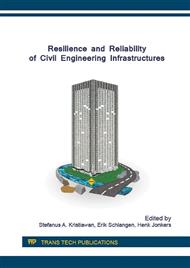p.214
p.220
p.226
p.233
p.240
p.246
p.252
p.259
p.265
Effect of Supplemental Damping on the Seismic Performance of Triple Pendulum Bearing Isolators under Near-Fault Ground Motions
Abstract:
The isolating system absorbs part of the earthquake energy before transferring it to the structure, by shifting the natural period of the isolated structure. This period shift results in a reduction in the inertial forces. It is clear that the effects of near-fault (NF) ground motions with large velocity pulses can bring the seismic isolation devices to critical working conditions. In this study, two three-dimensional RC buildings with the heights of 9.0m and 21.0m which are supported by Triple Friction Pendulum Bearing (TFPB) isolators are idealized. Various TFPB configurations are selected for isolation systems. There are also viscous dampers to limit the excess deformation of isolators. Nonlinear time history analyses were performed by using OpenSees to study the influence of supplemental dampers on structural responses such as isolator displacements and maximum drifts under ten near-fault ground motion records. The results show noticeable reduction in isolator displacement when using dampers. However, maximum drift rises considerablely. Moreover by increasing the period range or reducing the damping ratio of isolation system, maximum driftreduces but the displacement of isolator increases.
Info:
Periodical:
Pages:
240-245
Citation:
Online since:
July 2016
Authors:
Price:
Сopyright:
© 2016 Trans Tech Publications Ltd. All Rights Reserved
Share:
Citation:


